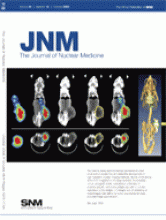TO THE EDITOR: We read with great interest the article by Terakawa et al. (1) concerning the discrimination between tumor recurrence and radiation necrosis by PET with l-methyl-11C-methionine (11C-MET). The authors studied 77 brain tumor patients after surgical excision and radiotherapy; all cases presented with an indication of recurrent tumor (metastasis or glioma) or radiation necrosis on MRI follow-up. The results showed that the mean lesion-to-normal ratio was the most valuable index for differentiating recurrence from radiation necrosis. A mean lesion-to-normal ratio greater than 1.41 provided the best sensitivity and specificity for metastatic brain tumor, and a mean ratio greater than 1.58 provided the best sensitivity and specificity for glioma (1).
Radiation necrosis is a potential long-term complication of radiotherapy or radiosurgery and is usually indistinguishable from true tumor recurrence by means of CT and MRI. Several advanced MRI techniques such as diffusion- and perfusion-weighted imaging and MR spectroscopy have been suggested to have increased sensitivity and accuracy, compared with conventional imaging (2); however, these techniques have certain limitations in cases of mixed necrosis and recurrence, and overlap between tumor recurrence and radiation necrosis groups has also been noted (3).
Functional metabolic imaging by PET and SPECT has been also evaluated. Nonetheless, PET studies are often cost-prohibitive and not widely available. Therefore, there has been much interest in using SPECT as a feasible alternative imaging technique. The major tumor-seeking radiotracers that have been extensively evaluated are 201Tl and 99mTc-sestamibi. Furthermore, several in vitro studies on glioma cell lines have substantiated a potential superiority of 99mTc-tetrofosmin (99mTc-TF) over 99mTc-sestamibi for brain tumor imaging, since 99mTc-TF accumulation is independent of the multidrug-resistance phenotype of the cell (4,5). On the basis of these reports, we investigated the in vivo imaging properties of 99mTc-TF in tumors of the central nervous system. 99mTc-TF is a tumor-seeking diphosphine that does not cross the intact blood–brain barrier, and uptake of 99mTc-TF depends on regional blood flow and cell membrane integrity, thus reflecting cellular metabolic status and viability. We fount that 99mTc-TF could successfully differentiate tumor recurrence from radiation injury (6). We also evaluated the relationship between glioma and meningioma proliferation (as assessed by the immunohistologic index Ki-67 and flow cytometry) and 99mTc-TF uptake. In both tumor types, we verified a strong positive linear correlation between tracer uptake and tumor proliferative potential and aggressiveness (7–9). Furthermore, we reported that 99mTc-TF SPECT could hold a role in differentiating neoplastic from nonneoplastic intracerebral hemorrhage (10). Thus, we propose that metabolic brain imaging by 99mTc-TF SPECT can contribute considerably to the management of patients who undergo radiotherapy and develop new lesions or symptoms. Comparative studies with other metabolic imaging techniques such as 11C-MET would be valuable to evaluate this critical issue.
Footnotes
-
COPYRIGHT © 2008 by the Society of Nuclear Medicine, Inc.







